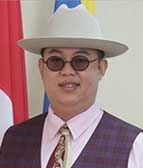ASEAN States Cooperation in the Control and Prevention of Illicit Drugs Trafficking
Downloads
The high modus operandi and increasing technological sophistication have implicate the transnational movement of illicit drug trafficking. The phenomenon of increased narcotics crime cases poses a threat to countries, including those in the ASEAN region. This type of crime poses a threat to the production and trade of illegal drugs. ASEAN, as a regional organization in Southeast Asia, is still facing several challenges, particularly the commitment of its member countries to combating illicit drug trafficking. Aside from funding issues, geographical location, cultural challenges, and social customs are all factors influencing the speed with which narcotics are handled. Several programs were initiated by each country in the ASEAN region with the primary goal of collaborating to reduce narcotics distribution and abuse. This article aims to analyze the sustainability of the ASEAN 2015 Drug-Free Program and the role of UNODC in the ASEAN region. The normative legal research method was used in this article, with primary and secondary legal sources. The article concludes that the program for dealing with narcotics crime begins with the ASEAN drug-free declaration, which harmonizes member countries' perspectives through their representatives to eliminate the cultivation, consumption, and trade of narcotics across national borders. As an international organization, UNODC (United Nations Office on Crime and Drugs) exists to facilitate cooperation and coordination through programs initiated with special narcotics agencies from each member country. Coordination between the two organizations is critical for the successful implementation of the program that has been initiated.
Downloads
Anggraini D, ‘Kebijakan ASEAN Dalam Menanggulangi Penyalahgunaan Narkotika Dan Obat-Obatan Berbahaya Di Asia Tenggara' (2016) 5 Jurnal Analisa Hubungan Internasional.
Apriyani MN, Suharto MA and Waluyo, ‘Pembaruan Peraturan Ekstradisi Dan Mutual Legal Assistance Indonesia Dalam Pengembalian Aset Hasil Korupsi Yang Berada Di Luar Negeri' (2023) 5 Crepido.
Ayu L. P. A, ‘Peran ASEAN Senior Officials on Drug Matters (ASOD) Dalam Menanggulangi Perdagangan Narkoba Di Filipina Tahun 2014 - 2019' (Universitas Islam Indonesia 2022).
Council of the European Union, ‘Regional Report on South East Asia and China' (2015) 1.
Fauzi, ‘95 Persen Narkotika Masuk Indonesia Lewat Jalur Laut' (Antara Kalteng, 2022) <https://kalteng.antaranews.com/berita/589145/95-persen-narkotika-masuk-indonesia-lewat-jalur-laut> accessed 30 March 2023.
Fenwick CG, ‘The Role of Organization in International Law' (2017) 35 American Society of International Law 524 <https://www.cambridge.org/core/journals/american-journal-of-international-law/article/role-of-organization-in-international-law/3B5642DB1833E406C6C36E9D132742ED>.
Hansford B, ‘UNODC World Drug Report 2022 Highlights Trends on Cannabis Post-Legalization, Environmental Impacts of Illicit Drugs, and Drug Use among Women and Youth' (United Nations Office on Drugs and Crime, 2022) <https://www.unodc.org/unodc/press/releases/2022/June/unodc-world-drug-report-2022-highlights-trends-on-cannabis-post-legalization--environmental-impacts-of-illicit-drugs--and-drug-use-among-women-and-youth.html> accessed 27 October 2023.
Harper N and Tempra N, ‘Drug Trafficking in the Golden Triangle: The Myanmar Problem and ASEAN Effectiveness' (2019) 1 Jurnal Sentris.
Ismail DPZ, ‘66th Session of the Commission on Narcotic Drugs' (2023) <https://www.unodc.org/documents/commissions/CND/CND_Sessions/CND_66/Item_3_-_Brunei.pdf>.
‘Joint Communique of The 33rd ASEAN Ministerial Meeting Bangkok, Thailand, 24-25 July 2000' Para. 56 <https://asean.org/joint-communique-of-the-33rd-asean-ministerial-meeting-bangkok-thailand-24-25-july-2000/>.
Kama IPS, Prameswari AAAI and Sushanti S, ‘Kepentingan Thailand Dalam Penerapan Kebijakan Legalisasi Ganja' (2019) 2 OJS Jurnal.
Kanato M, Sarasiri R and Leyatikul P, ‘ASEAN Drug Monitoring Report 2020. Bangkok: ASEAN Narcotics Cooperation Center.'.
Kartaatmaja AM, ‘Menuju Asean Bebas Narkoba 2015: Situasi Penyalahgunaan Narkoba Di Indonesia' (2014) 5 Aspirasi.
Kementerian Luar Negeri Indonesia, ASEAN 2025: Melangkah Maju Bersama (2015).
Mansfield ED and Pevehouse JC, ‘Democratization and International Organizations' (2006) 60 International Organization.
Nebi O, ‘Faktor Penyebab Pengguna Narkotika Di Kalangan Masyarakat' (2019) 3 Wajah Hukum.
Perwita AB and Mochamad YY, Pengantar. Hubungan Internasional (Remaja Rosdakarya 2005).
Prayuda R and Harto S, ASEAN Dan Kejahatan Transnasional Narkotika (Problematika, Dinamika, Dan Tantangan (Ombak 2020).
Singapore, ‘Agenda Item 11th of The Reconvened 64th Session of The Commission on Narcotic Drugs' (2021) <https://www.unodc.org/documents/commissions/CND/CND_Sessions/CND_64Reconvened/Statements_64th_Reconvened_CND/Item_11/Singapore_Item11.pdf>.
Solihin EB, ‘Peran Myanmar Menanggulangi Penyelundupan Dan Penyalahgunaan Narkoba Dalam Mendukung Pencapaian Drug-Free ASEAN 2015' (Universitas Muhammadiya Yogyakarta 2016) <https://etd.umy.ac.id/id/eprint/25916/>.
Supramono G, Hukum Narkoba Indonesia (Djambatan 2004).
United Nations Office on Drugs and Crime, ‘Thai Alternative Development Projects Showcased at International Workshop' (UNODC, 2011) <https://www.unodc.org/roseap/en/2011/12/alternative-development-chiang-mai/story.html>.
””, ‘The Government of the Lao PDR: National Drug Control Master Plan 2009-2013'.
””, Covid 19 and Drugs: Impact Outlook (United Nations 2021) <https://www.unodc.org/res/wdr2021/field/WDR21_Booklet_5.pdf>.
””, ‘The United Nations Office on Drugs and Crime (UNODC)' (United Nations Office at Vienna, 2023) <https://www.unov.org/unov/en/unodc.html#:~:text=The United Nations Office on Drugs and Crime (UNODC) is, Nations lead a program on terrorism.> accessed 31 October 2023.
UNODC, ‘Drugs and Precursors' (United Nations) <https://www.unodc.org/roseap/en/what-we-do/toc/drugs-and-precursors.html> accessed 8 April 2023.
””, ‘UNODC's History in Myanmar' (United Nations) <https://www.unodc.org/roseap/en/myanmar/history.html> accessed 8 April 2023.
””, ‘Vietnam's Country Programme' (United Nations) <https://www.unodc.org/roseap/en/vietnam/country-programme.html> accessed 8 April 2023.
””, ‘Drug Dependence Treatment in Cambodia' (United Nations, 2010) <https://www.unodc.org/roseap/en/2010/02/unct/story.html> accessed 10 April 2023.
””, Country Programme 2017-2020 (Making Indonesia Safer from Crime, Drugs and Terrorism) (United Nations 2018).
””, ‘First Coffee Export by Former Opium Farmers in Laos' (United Nations, 2021) <https://www.unodc.org/roseap/laopdr/2021/06/coffee-export-former-opium-farmers/story.html> accessed 8 April 2023.
””, ‘Human Rights Take Centerstage in UNODC Philippines' Anti-Drug Initiatives' (United, 2022) <https://www.unodc.org/roseap/en/philippines/2022/03/anti-drug-initiatives/story.html> accessed 10 April 2023.
””, ‘Thai Agencies and UNODC Discuss The Future of New Narcotics Code' (United Nations, 2022) <https://www.unodc.org/roseap/en/2022/04/thailand-new-narcotics-code/story.html> accessed 8 April 2023.
””, ‘UNODC and Malaysia Discuss Establishing Early Warning Mechanism for Synthetic Drugs' (United Nations, 2023) <https://www.unodc.org/roseap/malaysia/2023/03/early-warning-mechanism-synthetic-drugs/story.html> accessed 8 April 2023.
Copyright (c) 2023 Sinar Aju Wulandari, Putri Kirana

This work is licensed under a Creative Commons Attribution 4.0 International License.
















